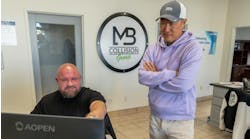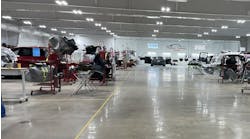Becoming more of a math wizard will help you thrive in the industry
My guess is you know all the numbers of your favorite hobby or leisure activity. You have to get the most enjoyment out of your hobby.
So it makes sense we should put the same effort and research into compiling the numbers that create the results of our efforts as collision repair professionals. Unfortunately, as simple as that sounds, we, as an industry, are only just beginning to put this thought into practice. It has only been an accepted practice to run a collision shop as a business for about the past 10 years.
Progressive shop owners have embraced this process, yet there are still many shop owners and managers who haven't done so. The most obvious reason is that many people don't know where to start. At first glance, it can be intimidating, but it doesn't have to be. The best way to simplify it is to break it down into parts.
Measure it
This is the most important of all the basic premises that make up your numbers or key performance indicators (KPIs). You can measure just about anything, and you have to measure to improve.
Think about a drag racer. Each quarter mile race is timed (measured). The driver and the driver's team are working constantly to try to improve the time of the last run and go faster the next run. They're measuring each one and trying to do whatever is needed to improve with each successive run. Everything they do may not net a positive result; however, the cumulative total of their efforts to improve their times will do that. This same logic is needed to apply to your daily operation. As a shop owner or manager, what are the most important numbers for you to know?
Once you become completely involved with your numbers, you'll begin to measure everything. There are a few basic KPIs you can start with initially:
- close/capture ratio;
- cycle time;
- gross profit; and
- average repair order (RO).
Close/capture ratio
Close ratio is the number of estimates written (repair opportunities) vs. the number of estimates turned into repair orders (jobs). This KPI is the lifeblood of your shop. Most shops that don't track this number effectively believe they're great salesmen and capture just about every job that walks in the door. In reality, the average shop is at or below a 50 percent close ratio, which isn't a good number. If this is you, half of the opportunities coming to your door are being lost.
I've heard all the excuses when someone realizes they may be judged by this number. "That guy was just shopping," or "I know she's just cashing out." Don't listen to this. Every customer that comes to you needs repairs, not an estimate. Track this number and push for close ratio improvements weekly. If you have a management system, this will be easy for you to do. If not, it can be done by hand using a simple spreadsheet.
These numbers are directional, so look for ranges when measuring. A good goal to shoot for is 75- to 80-percent close ratio. This KPI will allow you to look at what your staff needs to do to improve. Do they need sales training, or do you need more work to the door? You'll get answers to these questions by measuring and then strategically putting together a plan to correct the deficiency. This would not be possible without measuring.
Look at this example of what a 25-percent improvement in your close ratio means. Your shop's average sales are $50,000 per month. By tracking estimates, you determine your close ratio is 50 percent. Your average repair order is $2,200. This translates to 22.7 cars per month on 45 opportunities (estimates).
If you add another 25 percent to your close ratio on the same number of estimates coming to your door – not one more new opportunity – you repair 33 cars at $2,200 each for total sales exceeding $72,000. Not bad for a few extra steps and coaching to become better. This KPI is one of the easiest to fix and one of the most important. Learn it well.
Cycle time
Cycle time was a buzz word for a few years and has been a confusing KPI for many shop owners. Insurance companies have been monitoring shops' cycle time for years through estimating systems. If you track your own, it rarely corresponds to the numbers the insurance company compiles. The reason is that there are about 20 different ways to measure it. Keys to keys, start time to completion time, time in the rental car, and on and on. Decide what set of measurements makes the most sense to you, and go from there. Use vehicle drop-off to vehicle completion. This set of numbers will provide you with information that can be most beneficial in affecting improvements in your repair process.
Remember, the idea is to increase your shops through-put numbers, (another important KPI) without changing its physical configuration. Simply put, this means getting more work done more efficiently in less time. Look at it analytically. Your shop has square footage limitations. You can't bring another repair job in to a stall until the one in it is done. Getting cars through the shop faster is good for you, the insurance company and your customer.
There are several subcategories under the general drop-off to completion heading. Drop-off to body, time from body to paint, time from paint to reassembly, and time from reassembly to completion are a few. If you attack each subcategory and speed up a bottleneck in each one, the repair-cycle-time process will improve.
Are poor estimates causing delays in the body shop waiting for parts or supplemental estimates to be done? Is your paint shop a bottleneck? Do you need more staff? Less staff? These questions can be addressed by measuring these categories and analyzing the numbers. Remember, the first step to fixing problems and growing your business is to know and understand these numbers. The next step is using the numbers effectively to produce better results.
Gross profit
Do you know how much profit you make on each repair? In each category on your repair order? Are you getting the right parts discounts/markups? How do you know? Gross profit on each repair is how you make your money. This fluid cash after all the parts and labor on a job are paid for is what pays your salary, phone/Internet, rent, mortgage, heat and light bills.
Each department on your repair order should be benchmarked for a certain level or percentage of profit. On average, I look to make about 60 percent profit on labor, 28- to 35-percent profit on parts, and 35 percent on paint and material. Overall, a 45- to 50-percent gross on the entire job is what I minimally accept or expect. If you have a management system, this number will be easy to produce, but it can be compiled by hand on a spreadsheet. Knowing this number allows you to correct overpayments to techs, duplicated parts on a job or missed supplemental items. If you maintain an average of 50-percent profitability on each repair, many of the other KPIs will fall into place naturally. This number is a must to measure, know and thoroughly understand.
Average repair order
The current business environment is challenging. All business owners are looking for ways to increase business and profit. Knowing your average repair order's dollar amount and makeup, or mix, is an important KPI. Your average RO is easy to calculate. Take all your pretax sales and divide them by the number of vehicles your shop fixed in a certain time frame. Here's an easy-to-understand example. Your total sales for the past 90 days are $250,000. During those 90 days, you fixed 135 cars. Divide $250,000 by 135 to get $1,851, which is your average repair order.
In a market that's losing repairable collisions at an alarming rate every year, it's going to be difficult to increase your sales numbers by adding volume alone. By increasing your RO dollar on each repair job, even by just a small amount, you can make a dramatic affect on your total sales numbers and profitability.
Let's look at the 135 cars you fixed in the past 90 days. On every repair order, you make an effort to add at least $20 to the job. That is about one-half in labor, or the clips you've been giving away free, or the few extra dollars in paint and material you didn't charge for, or the glue you forgot to bill for or ... well you get the picture. With a little diligence and minimal effort, you should be able to add $20 to each RO easily. If we take the 135 (number of cars you fixed) and multiply that by $20, you get a net sum of $2,700. Multiply that number by 4, (one year's worth), and you're looking at a substantial increase in profit – $10,800 to be exact – without fixing one additional car.
You should also know what makes up each RO.
In almost every scenario, your greatest profit potential will be in labor sales. Without fail, you'll make more money from labor than any other category. On every RO, you'll generally sell a combination of several things. I've listed the average categories, and the average profit potential associated with each one:
- labor - 60 percent;
- paint and material - 35 percent;
- parts - 28 percent; and
- sublet services - 30 percent.
As you can see, labor offers the best opportunity to generate profits. If you can't increase your average RO dollar, try to increase the amount of labor on each RO. Do both, and you can affect positive change.
I think I speak for most of us in this industry when I say we're not math wizards. We love cars and know how to fix them. This economy demands change, so you have to adapt. Learning to become more of a math wizard is something you absolutely need to do to thrive in this evolving industry.
As you can see in the calculations I've used as examples, this part of your business toolbox doesn't have to be complicated to be helpful. I suggest keeping it simple. However, it's extremely important to learn these numbers and grow as an owner and manager by using the information they provide wisely. There are a host of areas you can and should measure once you get started on this project. If you don't look at any more than the categories I've listed here, your business will be much better for it.




